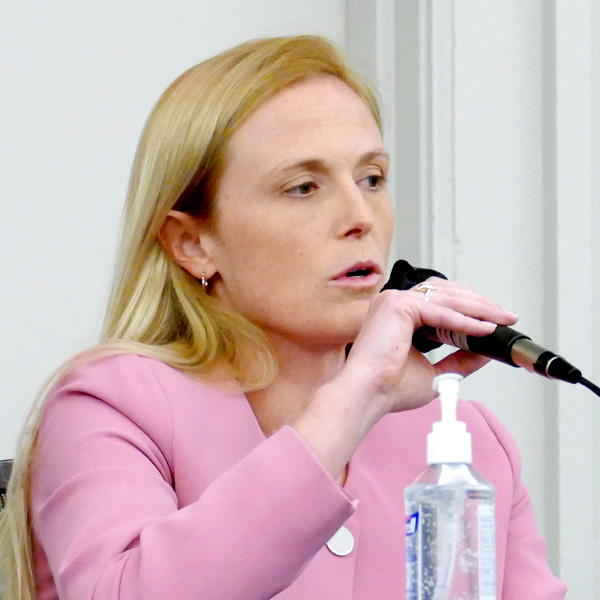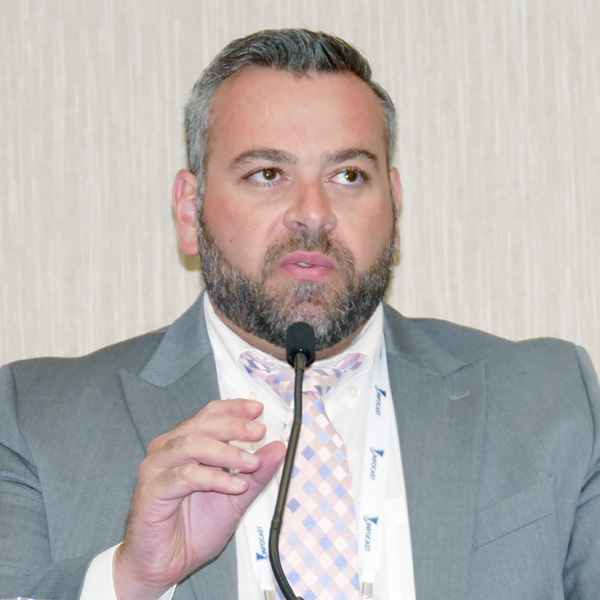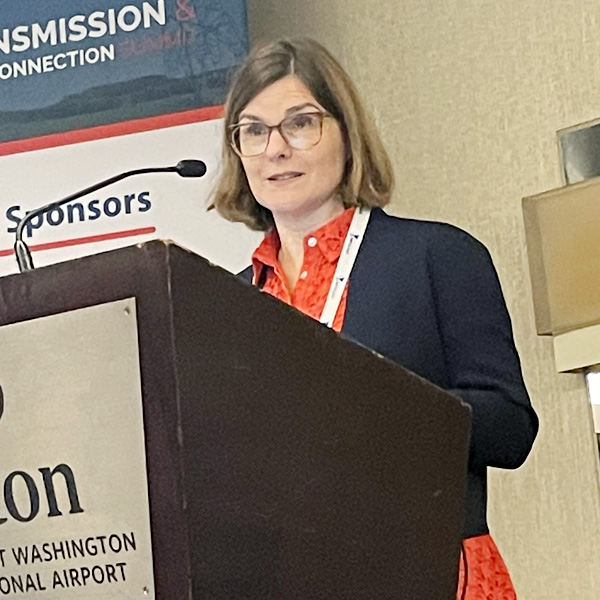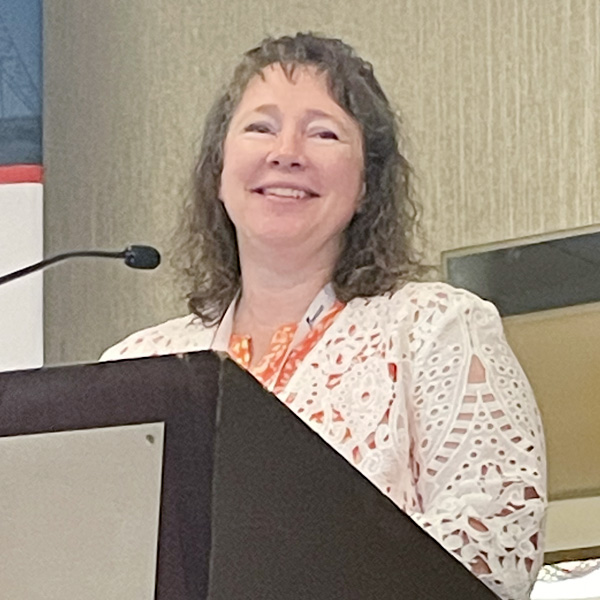
ARLINGTON, Va. — Time is running out to build the infrastructure needed to meet climate challenges, transmission planners, generation developers and others warned last week.
“The things that we have done well are pretty modest. We’re not seeing steep changes,” Liza Reed, the Niskanen Center’s electricity transmission research manager for climate policy, said in one of many related discussions during Infocast’s Transmission & Interconnection Summit, held June 20-22 at the Hilton Crystal City hotel. “We’ve been talking about backbone [transmission] for decades — I mean decades. So, it’s not even new. … That conversation just really needs to mature very quickly.”
It’s inaccurate to describe the challenge of matching generation and transmission as a “chicken and egg” dilemma, said Joseph Rand, senior scientific engineering associate for the Lawrence Berkeley National Laboratory’s Electricity Markets and Policy Group. “When we look at the interconnection queues, we already have 1,400 GW — not megawatts, gigawatts — that’s ready to interconnect to our system now. … It’s not, ‘If we build it, they will come.’ They’re waiting for us to build it.”
“In the planning world, 2030 is tomorrow — and 2040 is the day after,” said Himali Parmar, vice president of energy advisory services, interconnection and transmission at ICF International.
 Sarah Bresolin, ENGIE North America | © RTO Insider LLC
Sarah Bresolin, ENGIE North America | © RTO Insider LLC
“Lawrence Berkeley National Labs has this great graph that shows all the different RTOs and compares the [renewable portfolio standards]. And it shows that New York and ISO New England have the greatest need to bring renewables onto their grids and are bringing the least on,” said Sarah Bresolin, director of government and regulatory affairs and wholesale markets policy for ENGIE North America.
But it wasn’t all doom and gloom among the hundreds who attended the conference. FERC’s April Notice of Proposed Rulemaking on transmission planning and cost allocation (RM21-17) and its June 16 NOPR to unclog interconnection queues (RM22-14) won mostly positive reviews.
“We’ve talked about a lot of problems, and I wouldn’t want to leave this panel thinking that there aren’t opportunities,” said Bresolin.
Planning Models not Proactive
Jay Caspary, vice president of consultancy Grid Strategies, said FERC was right to call for proactive, scenario-based transmission planning in the April rulemaking.
“It’s going to take decades to build the grid of the future, so we need to think about what’s the resource mix going to be, and that’s above and beyond the known knowns. We know what units are going to retire in the next few years and know what generators are coming online. But the planning, the models [and] the analyses don’t reflect the commitments that have been made by utilities to get to zero carbon by 2040,” he said. “If you look at planning models now looking out five to 10 years in the future, there’s probably very little electrification in there. And don’t we all really think that electrification is coming in terms of transportation or buildings and industrial processes?
 Arash Ghodsian, EDF Renewables | © RTO Insider LLC
Arash Ghodsian, EDF Renewables | © RTO Insider LLC
“We need to think strategically about what this grid needs to do … to share resources across time zones,” added Caspary, a former SPP planner. “We need a grid that’s bigger than the weather patterns and storms, so that we can move energy and capacity to keep the lights on. And we need studies where everybody’s involved in how we’re going to … decide what the right metrics are to quantify the benefits. I think that will be a big challenge for us, but I’m sure we’re up for that. I mean, we put a man on the moon.”
Arash Ghodsian, senior director of transmission and policy for EDF Renewables, said FERC should “bifurcate” transmission planning and cost allocation to prevent cost issues from short-circuiting planning.
Johnny Casana, North American strategy director for wind and solar developer Pattern Energy, said dealing with that lag in the Eastern Interconnection doesn’t compare to the challenges of the Western Interconnection.
 Johnny Casana, Pattern Energy | © RTO Insider LLC
Johnny Casana, Pattern Energy | © RTO Insider LLC
“I would rather have cost allocation be a hurdle at the end rather than at the beginning of the process,” he said. RTOs should “not let cost allocation discussions stop them from planning.”
Ghodsian also said he hopes FERC’s interconnection rulemaking will ensure the rest of the country adopts best practices, similar to those in MISO. The RTO’s interconnection rules are “three to four years ahead” of its neighbors SPP and PJM, “so there’s always going to be some sort of a lag between all three neighbors,” he said.
“There’s 38 balancing authorities in the West, and they are not integrated, certainly not for transmission planning; not for planning capacity shortfalls that are driven by extreme weather events for their entire region,” he said. “There’s some great studies that have come out in the last year or two talking about with the amount of changes that all of these different states have put on the books already and voluntary commitments that utilities have made to basically get out of coal within the next 10 or 15 years. … Without a wholesale electricity market or an RTO, you’re looking at $3 [billion] or $4 billion extra per year in [costs] … for the privilege of failing on your collective greenhouse gas reduction goals — because you can’t get there.”
Interregional Planning Lacking
Panelists also lamented the lack of interregional transmission development since Order 1000 in 2011.
 FERC Commissioner Allison Clements | © RTO Insider LLC
FERC Commissioner Allison Clements | © RTO Insider LLC
FERC Commissioner Allison Clements, who spoke to the conference June 21, said the commission plans to revisit the issue.
“I think interregional transfer capabilities is low-hanging fruit in terms of something that has widespread support; [it] certainly has support at the commission,” she said. “FERC has a role to play, because it’s just such a massive challenge. And the idea that it can get done in a ‘1,000 flowers blooming’ approach, as opposed to federally [mandated], seems hard.”
Clements said she hoped the commission’s April proposal will lead to more initiatives like MISO’s Multi-Value Projects. She also called for prudence in spending.
“If we are going to build out the type of transmission that every credible study tells us we’re going to need to do to serve customers reliably, we have to be careful about costs. If you want to build the big transmission to interconnect regions — which we need — get on board with grid-enhancing technologies; get on board with the ability of distributed energy resources to provide low-cost, flexibility to the system, because we need all of it. … Let’s ensure that [we are] taking advantage of the cheapest resources first.”
DOE Initiatives
 Michelle L. Manary, Department of Energy | © RTO Insider LLC
Michelle L. Manary, Department of Energy | © RTO Insider LLC
Speaking after Clements, Michelle L. Manary, acting deputy assistant secretary for the Department of Energy’s Energy Resilience Division, described the department’s Building a Better Grid Initiative, announced in January. (See DOE to Tackle Tx Siting, Financing, Permitting in Better Grid Initiative.)
As part of the initiative, the National Renewable Energy and Pacific Northwest National labs will help DOE identify where transmission upgrades could relieve congestion resulting from electrification and increased renewable generation.
“The whole theory here is we have a case that is blessed by the regions; this is not something the labs go and do by themselves. … It really is working with everybody to find that those strong base cases and identify those areas,” Manary said.
She also discussed DOE’s transmission facilitation program, which allows it to borrow more than $2.5 billion to create a revolving fund to purchase capacity on new transmission to reduce developers’ risks. (See DOE Seeks Input on Tx Loan, ‘Anchor Tenant’ Programs.)
“The moment that DOE signs that capacity contract, we’re looking to resell it,” she said. “What I don’t know … is do we get keep that money [from transmission sales]? We are [in] active conversations with the Treasury.”



